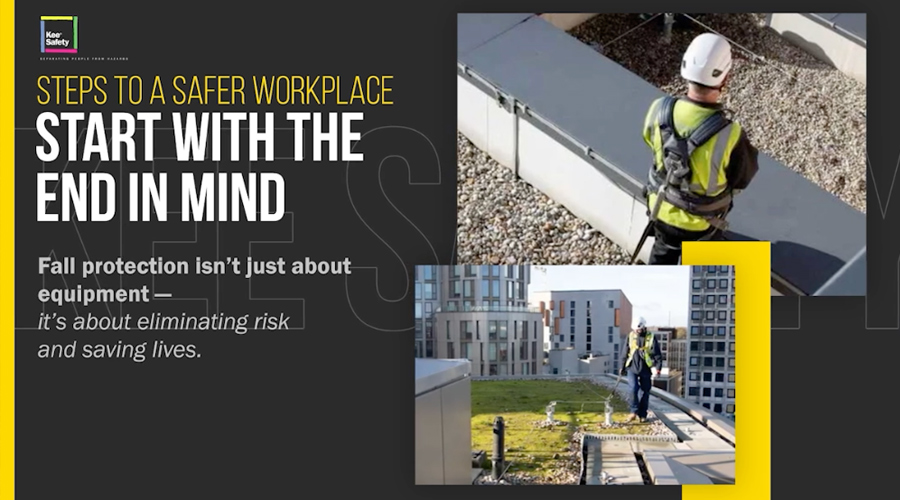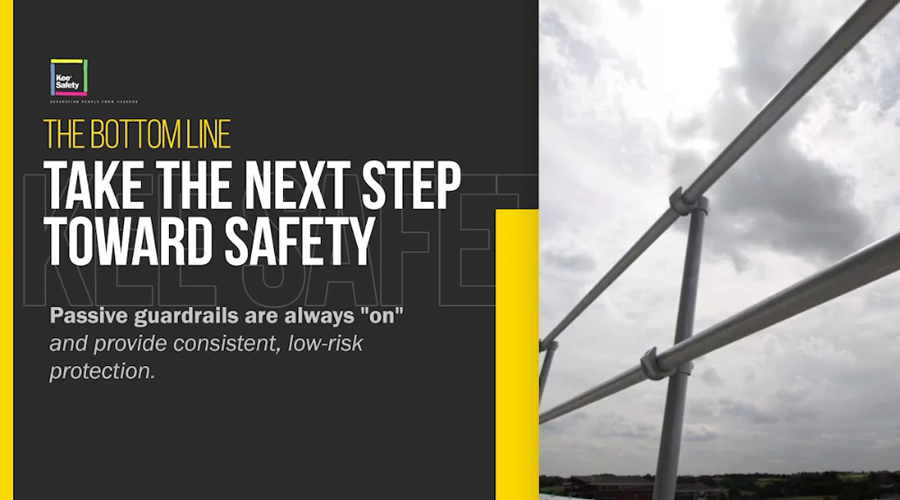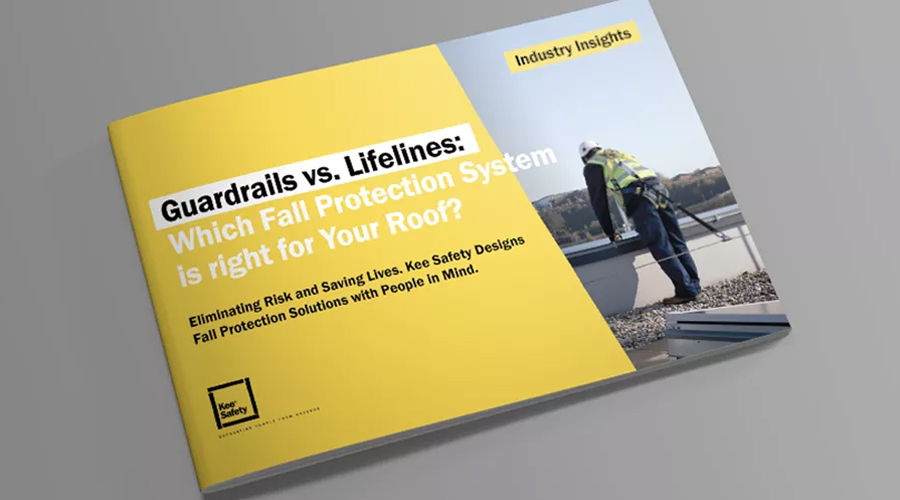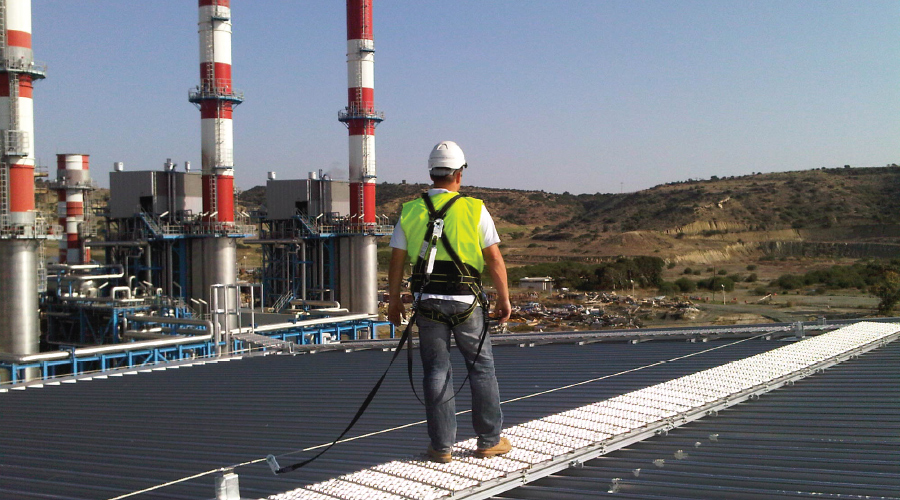SPONSORED
Kee Safety, Inc. - Branded Feature
Guardrails vs. Lifelines: Navigating Rooftop Fall Protection
Every rooftop presents unique risks — and every decision you make about fall protection can mean the difference between a safe day’s work and a catastrophic incident. Falls remain one of OSHA’s most frequently cited violations and are the leading cause of serious injuries and fatalities in construction and facility maintenance. Whether you’re managing an aging facility or designing a new one, the question is the same: Do we need a guardrail system or a lifeline system?
This article dives deep into the differences between passive and active systems, how to assess your rooftop, and what practical steps you can take to choose the right solution for your people and your budget.
1. Why the Right Fall Protection System Matters
Rooftop fall protection isn’t one-size-fits-all. Every facility has different access needs, user types, and risk tolerances. The right system reduces liability, simplifies compliance, and — most importantly — protects lives. When comparing passive and active systems, it’s about more than equipment; it’s about deciding who bears the responsibility for safety: your people, or your system
2. Passive vs. Active Fall Protection
Guardrails (Passive System)
Guardrails are considered “passive” fall protection. They protect workers without requiring any action, training, or equipment on the worker’s part. Once installed, guardrails are always in place and functioning, creating a physical barrier that prevents workers from reaching a fall hazard — no harnesses, lanyards, or user involvement needed. Passive systems eliminate user error and offer consistent protection for anyone on the roof.
Lifelines (Active System)
Lifelines are classified as “active” fall protection. Workers must wear a harness, understand how to use it, connect to an approved anchor point, and work within the system’s defined limits. These systems include horizontal or vertical lifelines, often using tensioned cables anchored to the rooftop or structure. Active systems rely on user behavior, training, and proper equipment usage — which adds complexity and risk of error

3. Four Key Decision Factors for Choosing a System
- Frequency of Access
If your rooftop is accessed frequently — for HVAC maintenance, inspections, solar panel servicing, or any other routine activity — a passive guardrail system offers consistent protection for all users, every time. Lifeline systems may be more appropriate for rooftops that are rarely accessed, such as once or twice a year.
- Type of Users
Guardrails provide protection for anyone on the roof, regardless of their experience level or safety training. Lifeline systems, by contrast, should only be used by trained personnel. If outside contractors or multiple departments access your roof, a guardrail system reduces your liability and the need to manage who has received fall protection training.
- Structural and Design Considerations
Guardrails add weight and may require wind calculations, ballast, or fixed mounting depending on your system. Lifelines exert different forces and need properly engineered anchor points and adequate fall clearance below. Not every rooftop is suited for both options — a safety assessment can help determine what’s feasible.
- Regulatory Compliance
OSHA allows both passive and active systems — but ANSI standards and many safety professionals prioritize passive protection when possible. In fact, some jurisdictions or safety policies specifically require guardrails where they are feasible. While both solutions can be compliant, it’s important to choose the one that best aligns with your risk profile and work environment
4. Risk vs. Responsibility
The difference between guardrails and lifelines isn’t just technical — it’s legal, operational, and cultural.
- Lifelines place the burden of safety on the individual. Each worker must wear the proper PPE, know how to inspect and connect to the system correctly, follow training procedures and safe usage guidelines, and remain alert to fall clearance distances and anchor point locations.
- Guardrails shift that responsibility to the system itself. Once installed, guardrails provide continuous, passive protection with no user action required, equal safety for trained employees and third-party contractors, and fewer points of failure due to human error or non-compliance.
For organizations aiming to reduce liability, minimize administrative oversight, and ensure consistent protection for all rooftop personnel, a passive solution like guardrails is often the more effective, reliable choice

5. Cost Considerations Beyond the Price Tag
At first glance, lifeline systems can appear less expensive — especially in terms of materials and installation. But the real cost of active systems includes:
- User training (initial and ongoing)
- Annual inspections and recertifications
- Harness and PPE management
- Supervision and enforcement
Guardrails may involve a higher initial investment, but they offer low maintenance costs, longer service life, and no need for user gear or certification. Over time, many facility managers find passive systems more cost-effective — especially on buildings with high foot traffic
6. Case in Point
A pharmaceutical facility with rooftop chillers opted for guardrails after realizing that outside contractors accessed the roof weekly — and weren’t reliably trained. Another site with a rarely accessed utility roof chose lifelines to minimize visual impact. Both facilities achieved compliance, but each matched its fall protection system to its actual usage pattern. This underscores the importance of starting with a clear understanding of how your rooftop is used and who is using it
7. Practical Strategies for Creating a Safety-First Workplace
- Conduct a formal safety assessment to identify high-traffic vs. limited-access areas.
- Consider a hybrid approach: guardrails in high-traffic areas and lifelines for limited-access zones.
- Review your contractor management policies — how often do third-party workers access your roof?
- Budget for the full lifecycle cost of your fall protection system, including inspections, training, and equipment replacement.
- Consult a qualified fall protection professional to verify compliance with OSHA, ANSI, and local requirements.
8. Start With the End in Mind
Choosing the right fall protection system starts with understanding how your rooftop is used — and who is using it. There’s no universal solution. The safest, most cost-effective choice will always depend on how often people access the roof, who those people are, what tasks they perform, and how much oversight you can realistically provide.
In many cases, a hybrid approach — using guardrails in high-traffic areas and lifelines for limited-access zones — offers the best of both worlds. Fall protection isn’t just about equipment — it’s about eliminating risk and saving lives. Whether you go with guardrails, lifelines, or a combination, be sure to consult a qualified fall protection professional. The safest rooftops aren’t just compliant — they’re designed with people in mind.












